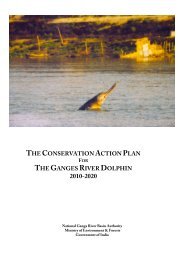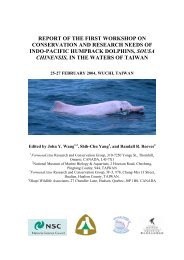Report of the Second Workshop on The Biology and Conservation of ...
Report of the Second Workshop on The Biology and Conservation of ...
Report of the Second Workshop on The Biology and Conservation of ...
You also want an ePaper? Increase the reach of your titles
YUMPU automatically turns print PDFs into web optimized ePapers that Google loves.
2001. Previously sighted near Thai/Cambodianborder by Nels<strong>on</strong> (1999).(3) Indo-Pacific humpback dolphin: Foursightings during 2001. Sighted around Koh K<strong>on</strong>gIsl<strong>and</strong>, al<strong>on</strong>g Koh K<strong>on</strong>g Province coastline <strong>and</strong>nor<str<strong>on</strong>g>the</str<strong>on</strong>g>rn Komp<strong>on</strong>g Som Bay. Based <strong>on</strong> sightings<strong>and</strong> interview surveys during 2001, populati<strong>on</strong>appears localized in specific areas <str<strong>on</strong>g>of</str<strong>on</strong>g> Cambodiancoastal waters.(4) Bottlenose dolphins (Tursiops aduncus/truncatus): Based <strong>on</strong> boat surveys during2001, bottlenose dolphins appear to primarilyinhabit <str<strong>on</strong>g>the</str<strong>on</strong>g> <str<strong>on</strong>g>of</str<strong>on</strong>g>fshore waters between Koh R<strong>on</strong>g/Koh R<strong>on</strong>g Sam Laem Isl<strong>and</strong>s <strong>and</strong> Koh Tang/Koh Prins archipelagos. During boat surveys in2001, all Tursiops sp. lumped into <strong>on</strong>e category,“bottlenose dolphins”. Although two species <str<strong>on</strong>g>of</str<strong>on</strong>g>bottlenose dolphins have now been recognized(Wang et al. 1999, 2000a, 2000b; Rice 1998),<strong>on</strong>ly <str<strong>on</strong>g>the</str<strong>on</strong>g> Indo-Pacific bottlenose dolphin has beenc<strong>on</strong>firmed to occur in Cambodian waters. Fur<str<strong>on</strong>g>the</str<strong>on</strong>g>rat-sea observati<strong>on</strong>s <strong>and</strong> collecti<strong>on</strong> <str<strong>on</strong>g>of</str<strong>on</strong>g> specimenmaterial required to c<strong>on</strong>firm species occurring inCambodian waters.(5) Pantropical spotted dolphin: Foursightings in 2001. Occurs around <str<strong>on</strong>g>of</str<strong>on</strong>g>fshore isl<strong>and</strong>s<str<strong>on</strong>g>of</str<strong>on</strong>g> Koh Tang <strong>and</strong> Koh Polou Wai. Sighted <strong>on</strong>ce inassociati<strong>on</strong> with dwarf spinner dolphins.(6) Spinner dolphin, dwarf form (Stenellal<strong>on</strong>girostris roseiventris): Three sightings during2001. Sighted around <str<strong>on</strong>g>of</str<strong>on</strong>g>fshore isl<strong>and</strong>s <str<strong>on</strong>g>of</str<strong>on</strong>g> KohTang, Koh Prins <strong>and</strong> Koh Polou Wai.(7) L<strong>on</strong>g-beaked comm<strong>on</strong> dolphin, IndianOcean form (Delphinus capensis tropicalis): Onesighting west <str<strong>on</strong>g>of</str<strong>on</strong>g> Koh Polou Wai (45 m waterdepth). Extremely l<strong>on</strong>g beaks, characteristic <str<strong>on</strong>g>of</str<strong>on</strong>g>tropicalis type (Rice 1998; Perrin 2002; Jeffers<strong>on</strong><strong>and</strong> Van Waerebeek 2002).(8) False killer whale: One sighting during2001. Large group sighted 5 km west <str<strong>on</strong>g>of</str<strong>on</strong>g> Koh R<strong>on</strong>gSam Laem Isl<strong>and</strong> (26 m water depth).(9) Short-finned pilot whale: One specimenfound injured (died three days later) in coastalwaters <str<strong>on</strong>g>of</str<strong>on</strong>g> Kep Province, February 2001.(10) Dug<strong>on</strong>g: Known to occur in Cambodiathrough retrieval <str<strong>on</strong>g>of</str<strong>on</strong>g> by-caught specimens during2001 <strong>and</strong> interviews with local people. No dug<strong>on</strong>gsyet observed during boat-based surveys. Based<strong>on</strong> interview surveys, a small remnant populati<strong>on</strong>is thought to exist, possibly ranging between PhuQuoc Isl<strong>and</strong> in Vietnam <strong>and</strong> <str<strong>on</strong>g>the</str<strong>on</strong>g> Kampot <strong>and</strong> Kepwaters <str<strong>on</strong>g>of</str<strong>on</strong>g> Cambodia. Previously recorded fromKoh K<strong>on</strong>g Province in early 1990’s (Nels<strong>on</strong> 1999),however recent interview surveys indicate thatdug<strong>on</strong>gs no l<strong>on</strong>ger occur in this area.Populati<strong>on</strong> statusMek<strong>on</strong>g River<strong>The</strong> populati<strong>on</strong> appears to be small <strong>and</strong> restrictedin distributi<strong>on</strong> during <str<strong>on</strong>g>the</str<strong>on</strong>g> dry seas<strong>on</strong>. Fourdedicated surveys were c<strong>on</strong>ducted over <str<strong>on</strong>g>the</str<strong>on</strong>g>entire stretch <str<strong>on</strong>g>of</str<strong>on</strong>g> river from Kratie to <str<strong>on</strong>g>the</str<strong>on</strong>g> Laos/Cambodia border (a total <str<strong>on</strong>g>of</str<strong>on</strong>g> 914 km <strong>and</strong> 82.4hours <str<strong>on</strong>g>of</str<strong>on</strong>g> survey effort). <strong>The</strong> survey in May, at<str<strong>on</strong>g>the</str<strong>on</strong>g> height <str<strong>on</strong>g>of</str<strong>on</strong>g> <str<strong>on</strong>g>the</str<strong>on</strong>g> dry seas<strong>on</strong>, resulted in a directcount <str<strong>on</strong>g>of</str<strong>on</strong>g> 67 dolphins (range 56-88) (<str<strong>on</strong>g>the</str<strong>on</strong>g> highest<str<strong>on</strong>g>of</str<strong>on</strong>g> all four surveys). <strong>The</strong> total populati<strong>on</strong>s maynumber no more than 100 individuals. This is inagreement with results obtained by Baird (1999)in 1997 in independent surveys. He noted that <str<strong>on</strong>g>the</str<strong>on</strong>g>majority <str<strong>on</strong>g>of</str<strong>on</strong>g> <str<strong>on</strong>g>the</str<strong>on</strong>g> populati<strong>on</strong> probably spends most<str<strong>on</strong>g>of</str<strong>on</strong>g> its time in <str<strong>on</strong>g>the</str<strong>on</strong>g> Cambodian parts <str<strong>on</strong>g>of</str<strong>on</strong>g> <str<strong>on</strong>g>the</str<strong>on</strong>g> Mek<strong>on</strong>gBasin. Future surveys will attempt to estimate <str<strong>on</strong>g>the</str<strong>on</strong>g>proporti<strong>on</strong> <str<strong>on</strong>g>of</str<strong>on</strong>g> dolphins missed during surveys, inorder to provide a measure <str<strong>on</strong>g>of</str<strong>on</strong>g> precisi<strong>on</strong> <strong>and</strong> moreaccurately estimate abundance (Beasley <strong>and</strong> PhaySomany 2002).<str<strong>on</strong>g>Sec<strong>on</strong>d</str<strong>on</strong>g> <str<strong>on</strong>g>Workshop</str<strong>on</strong>g> <strong>on</strong> <str<strong>on</strong>g>the</str<strong>on</strong>g> <strong>Biology</strong> <strong>and</strong> C<strong>on</strong>servati<strong>on</strong> <str<strong>on</strong>g>of</str<strong>on</strong>g> Small Cetaceans <strong>and</strong> Dug<strong>on</strong>gs <str<strong>on</strong>g>of</str<strong>on</strong>g> SE Asia 19





